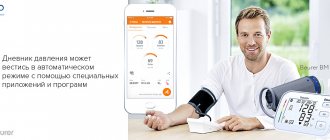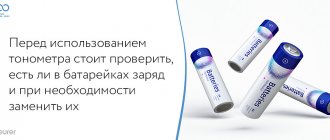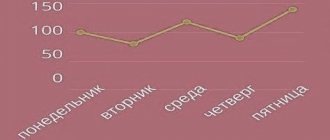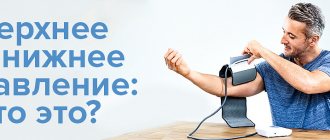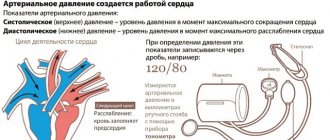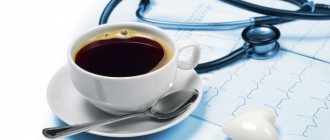The diary is an integral part of training for patients with arterial hypertension at the School of Health. These are your notes for memory - what you need to know, be able to do and do so that your blood pressure does not increase and your quality of life is good.
What needs to be controlled:
- Arterial pressure
- Body weight
- Waist
- Waist/hip index
- Total cholesterol
- Blood sugar
Blood pressure (BP) control
Regular blood pressure monitoring is not only blood pressure measurement, it is also a set of measures aimed at reducing the risk of complications. If an increase in pressure is detected, it is recommended:
- undergo examinations recommended by your doctor;
- determine the risk of complications; pay attention to risk factors;
- follow the rules below regarding nutrition, physical activity, etc.;
- regularly measure blood pressure: at least once a year - in case of a single unstable increase in blood pressure discovered by chance; at least once a month - if you feel well, but have a tendency to frequent or stable increases in blood pressure; at least 2 times a day - in case of exacerbation, stable increase in blood pressure and poor health.
If the pressure rises sharply and a crisis develops
- It is necessary not only to measure blood pressure, but also to write it down in a diary or on a piece of paper.
- Call an ambulance doctor.
- Take fast-acting drugs under the tongue: clonidine (clonidine) 0.075-0.15 mg, captopril (Capoten) 25-50 mg, nifedipine (Corinfar) 10 mg.
If chest pain occurs (manifestation of angina), take nitroglycerin under the tongue.
Do not use ineffective drugs - papazole, dibazole tablets.
Do not sharply reduce blood pressure over a short period of time.
Further actions will be determined by the ambulance doctor.
Benefits of Journaling
Thanks to regular data collection, the effectiveness of taking antihypertensive drugs increases, since timely detection of deviations makes it possible to accurately correct the treatment regimen.
How to measure blood pressure with a manual tonometer
- Regularity of blood pressure determination.
- Possibility of daily self-monitoring at home.
- Identification of situations that provoke an increase in values.
- Reducing the risk of developing cardiac and vascular complications.
- Allows you to evaluate the effectiveness of therapeutic measures.
- Improving quality of life.
Doctor's orders and recommendations
Following your doctor's recommendations will help:
- get rid of the disease if the pressure rises slightly;
- achieve a reduction in blood pressure faster and reduce the dose of medications if there is a persistent increase in blood pressure.
Principles of rational nutrition
Balance of energy intake from food (energy intake) and energy expenditure per day.
Balance of nutrients.
Proteins, fats, carbohydrates, vitamins and minerals must be supplied in sufficient quantities and in certain proportions.
Diet.
It is advisable to eat at least 4-5 times a day, at the same time, without overeating before bed.
Limiting salt consumption Consume no more than 5 g of table salt per day (a level teaspoon), increase the consumption of foods rich in potassium salts to 5-6 g.
Which foods are not recommended?
Fatty meats, strong meat broths, beef, lamb, pork fat, butter, mayonnaise, internal organs of animals, brains, caviar, lard, cream, baked goods, cream cakes, spicy, salty, fatty snacks, cocoa, chocolate, butter ice cream, alcoholic drinks.
What foods are recommended?
Bread and bakery products: bran, with phosphatides, salt-free, fortified.
Soups: vegetarian, fruit, dairy. Meat and fish dishes: low-fat varieties. Fruits, berries, dessert: any, a lot.
Dishes and side dishes from cereals and pasta: porridge, puddings, casseroles.
Eggs: white steamed omelettes.
Dairy products: low-fat varieties.
Fats: vegetable oil in salads.
Drinks: weak tea, juices, kvass, rosehip infusion, herbs.
Snacks: unsalted cheeses, low-fat sausages, vinaigrettes and salads.
Sauces: milk, vegetable broth, fruit, berry.
Preparation
One of the advantages of daily blood pressure measurement is the lack of special training. However, doctors recommend adhering to the following recommendations:
- Be sure to tell your doctor about all medications you take on an ongoing basis. Some medications may need to be stopped several days before the test.
- 5-7 days before the study you must give up alcoholic beverages.
- On the day of the examination, it is recommended to wear loose, cotton clothing that does not restrict movement.
- On the eve of the test, try not to experience any serious physical activity. You should also avoid stressful situations.
Bad habits, what to do
Smoking. Nicotine contained in cigarette smoke excites, increases the load on the heart, causes vasoconstriction, and increases blood pressure.
Alcohol. Under the influence of alcohol, control over your well-being is lost, and increased blood pressure becomes more dangerous. It is advisable to stop drinking alcohol. If this is difficult to do, you need to know that doses of alcohol of more than 30 g for men (this is a glass of vodka or cognac, a glass of wine, a can of beer) and more than 15 g for women per day, in terms of pure alcohol, are dangerous for arterial hypertension.
Examples of filling out tables
The blood pressure self-monitoring diary contains a table that can be compiled in any form. The table is compiled in accordance with the hypertensive patient’s own preferences, but it must accommodate the time frame necessary for recording blood pressure. If the patient cannot create a table on his own, the cardiologist offers a standard template for filling out, which can be printed and filled out at home.
An example of filling out a diary taking into account the pulse and possible complaints about the condition
The table can be displayed in a notebook. However, most modern people prefer table options that are made using computer programs. These records are made in Excel or Googledoc. Programs store information while performing important operations. The advantage of electronic options is sending data to a specialist without making an appointment.
The blood pressure monitoring diary is automated using the Excel program; a window is inserted into the table, into which values are added; it automatically reflects the time and date of filling.
Example of filling out an electronic form
When moving, the “Well-being” column is skipped, since in most cases it is not filled in, but if necessary, you can make an entry. Before consulting a doctor, print out the spreadsheet in advance to eliminate the possibility that the specialist does not have a computer at his or her workplace.
The benefits of physical activity. Self-control
Before you begin any physical activity, consult your doctor. At the height of the load, the pulse should not exceed 110-130 beats per minute.
Exercises should not provoke shortness of breath, profuse sweating, general weakness, or heart pain. The appearance of these symptoms indicates inadequacy of the loads and is a signal to reduce the intensity of the load and re-consult a doctor.
Warning! If your well-being after exercise worsens significantly (sleep, appetite, performance are disturbed, discomfort appears), then this requires a reduction in loads and repeated consultation with a specialist.
Smartphone application
Now you can use specially created software for mobile devices as a diary for hypertensive patients.
The most popular is the special ICare application - the program can be used both as a diary and as an activity tracker, as well as a clear, step-by-step guide to some exercises. As diary entries, it makes sense to keep records, for example, of glucose and temperature, and in automatic mode, through the use of a camera, you can measure blood pressure, pulse, PWV and some other physiological constants. So, thanks to scientific and technological progress, monitoring key biometric indicators has become much easier and more accessible. But it would be very good to measure blood pressure some time immediately after taking the antihypertensive effect of drugs, especially since now there is an excellent opportunity to control, enter and monitor indicators online.
A table for measuring blood pressure is the most important element in the management tactics of any hypertensive patient, and a responsible attitude towards one’s health is the basis for stabilizing hypertension.
How to start moving more
Entering the physical activity regime should be done gradually - the less physically active you are, the slower you should increase the load.
You should try to maintain regularity of classes 3-5 times a week. The most realistic way to start with measured walking in a training mode is a fast pace without stopping (approximately 120 steps per minute).
You need to start gradually, increasing the pace and distance of walking, having determined the initial individual limit of walking at a normal pace until you stop (fatigue, shortness of breath, pain, etc.). How to estimate body weight To easily determine the presence of excess weight, it is recommended to use the formula for men “height - 100”, for women “height - 105” or tables for determining normal body weight. It is very important to maintain a balance between the energy we receive from food and the energy expenditure of the body.
How to measure blood pressure correctly?
Daily tonometry for the purpose of self-control is a fairly simple procedure. The data obtained will be as accurate as possible if it is carried out taking into account all the necessary requirements:
- Prepare correctly for measurement. Do not smoke, drink alcohol, tea, coffee one hour before measurement. 5-10 minutes before tonometry, relax and sit quietly.
- Free your shoulder from clothing.
- To measure, choose the correct position at the table, leaning your back on the back of the chair. The hand should lie flat on the tabletop with the emphasis on the elbow.
- Wrap the tonometer cuff tightly around the shoulder so that its lower edge is 2 cm above the elbow. Fold the air ducts, lower them from the cuff to the pressure gauge along the inner surface of the arm.
- Carry out tonometry silently, without gesticulating;
- Press “start” to start measuring.
- Wait for the tonometer readings, take two subsequent measurements, maintaining an interval of 1-2 minutes.
- Determine the average values from the results of three measurements and write them down.
If the measurement is being taken for the first time, it must be done on both hands. Next, carry out tonometry on the hand (usually the left), where the indicators are higher.
Where to start losing weight
Step 1 is to analyze the causes of excess body weight. Start keeping a food diary and continue for at least one week.
Step 2 is to assess the compliance of energy intake with recommendations for reducing calorie intake to reduce body weight. Draw your own conclusions and, if energy intake was high, evaluate which products could be excluded.
Step 3 - start taking action. To lose weight, you need to balance your caloric intake and increase physical activity. It makes the most sense to start normalizing your weight by reviewing your eating habits and composition, losing a few extra pounds, and to achieve a more stable normal weight, you can start exercising.
When is daily blood pressure monitoring prescribed?
How does blood pressure behave during the day? This question is answered by daily blood pressure monitoring.
We talked about this research method with our regular consultant, general practitioner, cardiologist at Clinic Expert Voronezh, Kalinina Angelina Anatolyevna.
— Angelina Anatolyevna, what is daily blood pressure monitoring?
Daily blood pressure monitoring is a method of functional diagnostics. Its essence is repeated measurement of blood pressure throughout the day or more using a special device.
— What information about the patient’s health can daily blood pressure monitoring give the doctor? Tell us about the indications for prescribing ABPM
This research method is quite informative, and you can rely on it when diagnosing arterial hypertension. The purpose of the study is to determine a more accurate level of pressure and/or control the degree of its reduction during treatment.
Read the material on the topic: What are the reasons for high blood pressure?
This method also allows you to determine the average pressure values during the day, night, day (which, for example, is important when it is variable), the ratio of night and day pressure as a factor that allows you to assess the risk of cardiovascular outcomes.
Indications for ABPM are:
— “white coat hypertension” (pressure is within the normal range at home, but in a medical facility during repeated visits it turns out to be elevated);
— “masked” hypertension (when blood pressure is normal at a doctor’s appointment, but increases when measured at home or anywhere else);
— significant pressure fluctuations;
— various types of hypotension (low blood pressure);
- in pregnant women, including those with suspected preeclampsia;
— significant discrepancies between blood pressure readings at the doctor’s appointment and at home;
- suspicion of hypertension at night or lack of pressure reduction during this period of the day;
— assessment of the effectiveness of the therapy.
— Are there any contraindications to daily blood pressure monitoring?
There are no absolute contraindications for the examination. With ABPM, there are rather limitations in terms of placement of the device. For example, some kind of skin pathology in the area where the cuff is installed. Due to possible allergic reactions in some people, it is recommended to apply it on a thin cotton cloth.
Read the material on the topic: When there is nowhere lower. Understanding the causes of hypotension
An obstacle to applying a cuff may be a fracture, bruise, burn or its consequences. In this case, a healthy arm is selected, or the study is carried out after recovery.
— What is a 24-hour blood pressure monitoring device and how is the ABPM procedure performed?
The device consists of a cuff (like a conventional tonometer), a device for recording the data obtained, and tubes connecting the device to the cuff.
The device is in a case secured with a belt on the patient's shoulder or belt.
ABPM IS A VERY ACCURATE AND INFORMATIVE METHOD, THEREFORE IT IS APPROPRIATE TO USE IT IN THE PROCESS OF DIAGNOSIS OF HYPERTENSION
On the appointed day, the person comes for examination. A cuff is put on his arm, the device is secured, and the person leaves.
Over the next 24 hours, the device automatically measures the person’s blood pressure at intervals specified by the program. During the day, measurements are taken every 20-30 minutes, at night - every hour.
Before starting the measurement, the device warns about this with a sound signal. In this case, the person ideally needs to stop, straighten and relax his arm, and keep it in this position until the end of the full measurement cycle (i.e., pumping and deflating air). Do not move your hand during measurement. If the device “does not like” the measurement conditions (for example, the arm is bent and/or tense), it will try to make a new measurement.
Read the material on the topic: Holter (24-hour) ECG monitoring - complete instructions for the patient
The next day the person comes to the doctor who installed the device. The latter is removed, and the resulting data is decrypted and interpreted. On their basis, a conclusion is issued.
— How does ABPM differ from independent daily blood pressure measurement at certain hours? Why is keeping a blood pressure diary not enough?
Firstly, this is a more objective method, i.e. subjectivity, the level of technical proficiency of the person measuring, and possibly not entirely correct operation of the home apparatus are excluded.
Secondly, a large number of measurements are performed during ABPM. From a purely organizational point of view, it will be very inconvenient for a person to do this.
Thirdly, measurement conditions: it is easier to obtain information using the device.
ABPM is a fairly accurate and informative method, therefore, in my opinion, it is advisable to use it in the process of diagnosing hypertension.
— Daily blood pressure monitoring requires special training?
No.
— How reliable are the results obtained during the examination?
The reliability of the results obtained with ABPM is quite high - of course, subject to the conditions of the procedure. This, of course, is the serviceability of the device, its correct operation and wearing.
— How long after 24-hour blood pressure monitoring is the report ready?
Usually within an hour.
— What can affect the reliability of the conclusions obtained during daily blood pressure monitoring?
This is, of course, the patient’s behavior: failure to follow instructions, excessive hand movements, etc.; contact with water, high humidity, temperature above +50°C.
— How should a patient behave during the study? What can and cannot be done during 24-hour blood pressure monitoring?
Avoid rooms with high humidity (bath, sauna); normal hygiene procedures are possible, but contact of the device with water or steam must be completely excluded.
During the period of diagnosis of ABPM, it is necessary to wear cotton clothing (not synthetic or woolen).
While sleeping, carefully place the device next to you, trying not to squeeze the tubes.
Avoid active physical activity and movements involving the hands.
When measuring pressure, stop, straighten your arms and wait until the measurement is completed.
Keep a diary - the more detailed, the better. Periods of sleep and wakefulness, times of eating (you can additionally note the consumption of caffeine-containing drinks) and medications, activities performed (including climbing stairs, moving indoors and outdoors), emotional experiences, and stressful situations are noted.
Read the material on the topic: Vegetative-vascular dystonia: diagnosis or fiction?
If a person does not feel very well, and the measurement was taken recently, you can manually make an extraordinary measurement by pressing a special button (check this point separately with the doctor and/or nurse who will install the device on you).
If the cuff is twisted or has slipped, you should try to fix it yourself, and if unsuccessful, call the doctor conducting the study or another contact person.
You should not stay near sources of electromagnetic radiation for a long time.
— Angelina Anatolyevna, ABPM is an independent examination that allows you to identify the causes of hypertension or hypotension, or is it not enough to undergo only this one type of diagnosis in case of pressure changes?
This is a very informative method that allows you to identify high or low blood pressure as a syndrome, but to establish a diagnosis in each specific case, mandatory and, if indicated, additional studies are performed - laboratory and instrumental.
You can find out the cost of daily blood pressure monitoring by calling the phone number listed on the contacts tab
Please note: the service is not available in all cities
— In order to undergo examination in your clinic, do you need a doctor’s prescription?
Not necessary. You can be examined without a referral.
You may also be interested in:
Coronary heart disease: diagnosis and treatment
Serious question: what happens to the heart during an angina attack?
Why is electroencephalography needed?
For reference:
Kalinina Angelina Anatolevna
In 2007 she graduated from the Voronezh State Medical Academy named after. Burdenko.
From 2007 to 2008 she completed an internship in therapy, in 2010 she underwent professional retraining in the specialty “General Medical Practice (Family Medicine)”, and in 2017 – in the specialty “Cardiology”.
From 2015 to the present, he has held the position of general practitioner at Clinic Expert Voronezh, and since 2021, he has been a cardiologist. Reception is conducted at the address: st. Pushkinskaya, 11.
Stress
It is almost impossible to avoid many conflict situations, but you can learn to treat them correctly and neutralize them. The worst way to “discharge” is to take out your resentment and anger on loved ones, which causes double harm.
It is necessary to avoid overwork, especially chronic fatigue.
Alternate between mental and physical work.
The tips and rules outlined above can be supplemented by individual recommendations from the attending physician, which must be recorded in the diary.
results
A day later you need to see a doctor to remove the device. After removing the device, the collected data is transferred to a computer and processed. As a rule, the result is given out the next day.
The conclusion will indicate the preliminary diagnosis and data collected during the day. They include the following indicators:
- Systolic and diastolic blood pressure.
- Heart rate per day, per day and night, its minimum and maximum values.
- Daily index, which reflects the difference between daytime blood pressure and during sleep as a percentage.
- Time and speed of morning pressure rise, pulse pressure at different times of the day, etc.
Please note that the diagnosis indicated in the report is not final. Perhaps the doctor will additionally prescribe other diagnostic methods to clarify it.
Table of normal pressure by age
Table of normal blood pressure in a person depending on age (average values) according to the Zdrav-answer website:
| Age | Men | Women |
| 20 years | 123 by 76 | 116 by 72 |
| 30 years | 126 by 79 | 120 by 75 |
| 40 years | 129 by 81 | 127 by 80 |
| 50 years | 135 to 83 | 135 by 84 |
| 60-65 years | 135 by 85 | 135 by 85 |
| over 65 years old | 135 to 89 | 135 to 89 |
Diary design options
When filling out a diary, the most convenient option is to use tables. Of course, you can think up your own method, but there are already proven methods that allow you to make notes that are understandable to both the patient and the doctor. Consider two options for caps for the table for measuring blood pressure for every day.
| date | Time | Pressure indicators | Pulse rate | Description of health |
| 25-th of August | 8:00 | 130/86 | 68 | good |
| August, 26th | 8:00 | 132/86 | 73 | good |
| August, 26th | 20:00 | 142/88 | 78 | Weakness, fatigue |
This version of the diary is more suitable for those who, due to certain circumstances, are constantly at home. This is explained by the fact that here pressure is measured at any time of the day, indicating the date and time. Also, such a table can be used if a person at work has the opportunity to take measurements in a calm environment.
Patients should keep a blood pressure diary regularly
There is another popular option for creating a table header for keeping a blood pressure control diary.
| date | The first half of the day | Afternoon | Description of health | ||
| HELL | Pulse | HELL | Pulse | ||
| 25-th of August | 135/82 | 72 | 138/85 | 78 | Weakness |
| August, 26th | 140/88 | 76 | 145/92 | 82 | Headache, weakness, nausea |
This option for keeping a diary is suitable for absolutely everyone. In this case, you can measure blood pressure in the morning, immediately after waking up, and in the evening. It is better to decide which table to use together with your doctor. For some patients, measuring blood pressure twice is not enough, so the first table would be more appropriate.
Blood pressure should be measured regularly, adhering to the established schedule.
Tip: in order to remember to measure your blood pressure every day, it is recommended to tie the procedure to a specific action, for example, immediately after waking up and in the evening after dinner.
Considering the age of modern technology, we should not forget about electronic media. Instead of a notebook, it is quite possible to use a table created in Excel. In this case, you can also choose the hat that is convenient for you. In addition, you can create your own table with automatic date and time placement. If necessary, such a diary can be printed and shown to the doctor.
Instructions for measuring blood pressure
There are many different devices for measuring pressure. According to the principle of operation, they are divided into 3 groups: mechanical, semi-automatic, automatic (electronic). You can measure pressure with any tonometer; they all show reliable results. Let's look at step-by-step instructions for measuring blood pressure using a mechanical device:
- First of all, you need to put the cuff on your arm so that it is approximately 5 cm above the bend of your arm at the elbow.
- The stethoscope is placed on the cuff in the middle of the arm. The pulse will be clearly audible here when the air is deflated from the cuff.
- On average, the cuff needs to be inflated to 190-230 mmHg. (depending on normal blood pressure).
- Looking at the dial of the tonometer, they deflate the air, slowly (speed is about 3 mm per second) and listen to the pulse.
- The first beat is systolic blood pressure (written down in the table first), the end of the beats is distolic blood pressure (the number is written down as a fraction).
Advice! For daily measurements, it is advisable to purchase an electronic tonometer. It has high precision and easy operation.
Is it necessary to take measurements every day?
Thanks to daily blood pressure measurements, you can immediately notice pathological changes in the body. Keeping a diary allows you to track disorders in the body in a timely manner and take measures to improve your well-being, preventing the condition from worsening:
- The lowest and highest pressure over a certain period of time is assessed.
- The reasons why the pressure decreased or increased are monitored.
- The effectiveness of medications taken is determined.
- Signs of hypertension are recognized early on.
One of the columns indicates the names of the medications taken, the prescribed dosage and duration of the medication.
Who needs this?
Strictly speaking, every person who has crossed the forty-year mark should keep a diary for tracking their own blood pressure. And for people who have problems with blood pressure levels (hypertensives, hypotensives), this is necessary and mandatory. After all, its daily monitoring is an invaluable aid to the doctor in selecting specific therapy.
- Normal blood pressure readings in children in the table, reasons for fluctuations
Blood pressure is an extremely variable value. Under the influence of certain factors, it changes many times a day. It is impossible to assess a person’s condition from a single measurement at a doctor’s appointment. That is why experts recommend taking measurements at home yourself, then entering the data into a table.
By analyzing the daily fluctuations in the patient’s blood pressure level, the cardiologist will quickly establish a diagnosis and select the optimal dosage of medications.
Moreover, it has already been proven that a person’s involvement in the therapy process increases interest in recovery, and treatment brings better results.

